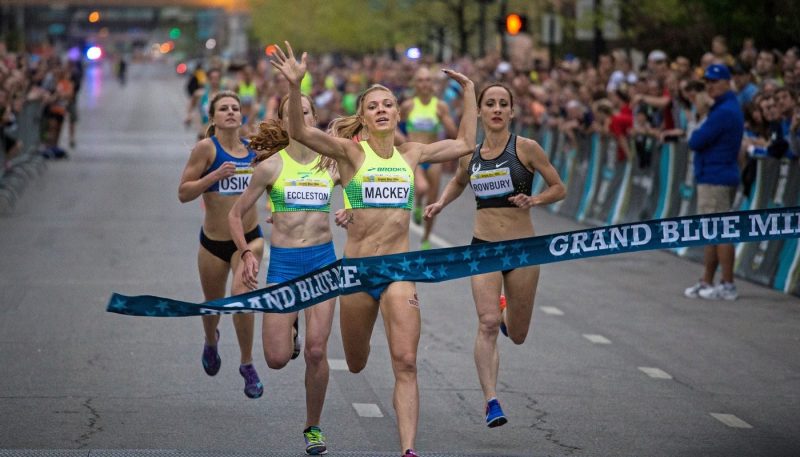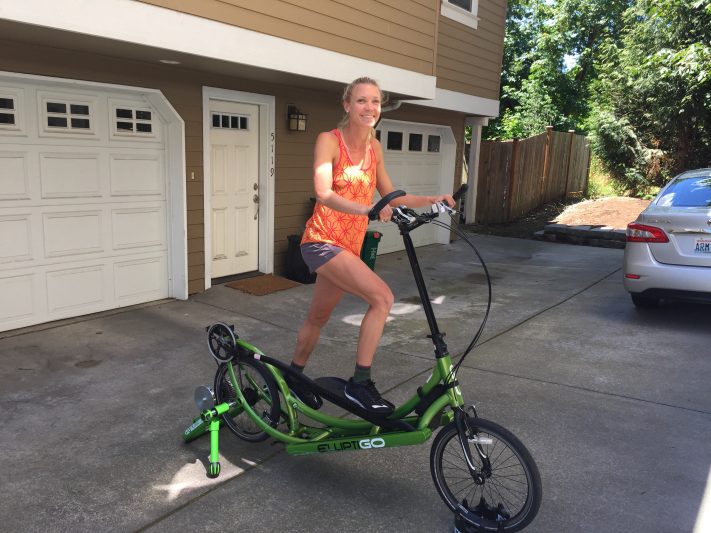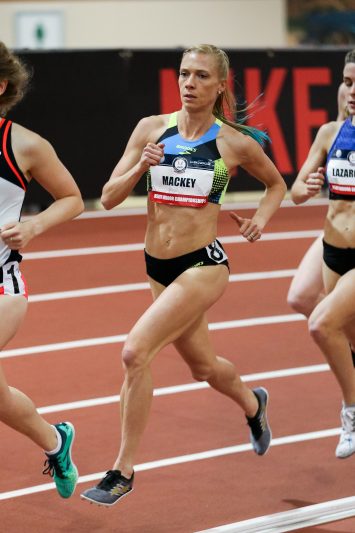
Photo Credit: Phil Roeder – creativecommons.org
Katie Mackey is a professional runner for Brooks Sports, specializing in the 1500m, 3000m, and 5000m distances on the track, but also having success on the roads and in cross country. She boasts personal best times of 2:01 (800m), 4:03 (1500m), 8:43 (3000m), and 15:04 (5000m). Originally from Fort Collins, Colorado, Katie (nee Follett) went to Seattle in 2006 to attend the University of Washington, where she became an 8 time All-American for the Huskies and contributed to a NCAA XC Team Title in 2008. She signed with Brooks Sports shortly after graduation in 2010 and married her Husband Danny in 2011. After living in different parts of the country for a couple years, Katie and Danny moved back to Seattle in 2013, and became the original members of the Brooks Beasts Track Club, with Danny as the Head Coach. From a starting roster of 4 athletes, their program has grown substantially to include many of the best middle distance runners in the sport.
In addition to Brooks, Katie has had many supporting brands in her corner, and ElliptiGO is proud to be part of that support system. Katie started incorporating ElliptiGO training in 2012 and has grown her relationship and success with the brand over those 5+ years. There were many notable achievements that followed in her career, which included a selection to the 2014 World Relay Championships, where she contributed to an American Record setting 4 x 1500m team. Her first Diamond League win came in 2015 in Stockholm (at the 3000m distance), and her first individual US Championship victory came in 2016 at the US Road Mile Championships (as seen in the photo above).
Most recently, Katie competed at the World Indoor Track & Field Championships in Birmingham, England. While Katie has competed in many world class events over her career, this was Katie’s first individual qualification for a World team following her Silver Medal finish at the USA Championships. And it came just months after having a significant setback with a sacral stress reaction last summer. Despite those injury challenges, Katie achieved the goal of reaching the World Championships, and finished 8th in the 3000m Final.
To help share the excitement of the experience and the journey it took to get there, we connected with both Katie and Danny after their return to the states. Here is what they had to say.
Danny Mackey Interview:
ElliptiGO:
As Katie’s Coach and Husband, you likely know her better than anyone else. What qualities and characteristics would you say separate her from others in this sport?
DM:
Katie is open-minded to learning. From observing the more successful professional athletes across different sports over the years, an athlete ideally has a little bit of a beginner’s brain. Katie is definitely that type of athlete and you can see it over her career, she has been a pro for 7 years and has gotten better each season. To evolve like that is extremely difficult. The second characteristic is she knows her purpose with her job. You need to have that in order to get through the struggles, and it shows up in Katie when you see how much she loves the process of training and how darn competitive she is in races. Another professional coach was running with me after the US Indoor champs this season and he said “man, it is fun watching Katie race because she puts all her chips on the table and leaves nothing” That is positive but it is also a dark spot, it is hard to go there without an authentic reason.

ElliptiGO:
When Katie was out with an injury last summer, how much of a role did ElliptiGO training play, and were you pleased with the benefits and results that followed?
DM:
Katie got hurt at the worst time, well maybe, I guess almost any time to get a serious injury is bad. But it was 2 weeks before the USA Championships. So she had 2 choices, rebuild for 2018 or double down and compete in the summer. Knowing Katie, and thinking about what I just said about her having purpose, Katie wanted to double down. The ElliptiGO was very important because it is the closest form of cross training to running that does not impact the body. Given Katie had a bone stress injury, the “GO” was ideal. So she basically mimicked the running workouts she would be doing normally, but did them on the ElliptiGO. She opened back up at the Falmouth Mile and got 5th, then went to Italy and got 3rd in the Roverto 3,000, her final race was the elite road mile in Newcastle, UK, she almost won but got outkicked for 3rd. It was a great way to end what could have been a disastrous season thanks to maintaining fitness on the GO.
ElliptiGO:
We know how important cross training is for injury management. But in terms of injury prevention, are there any patterns or specific placements of ElliptiGO sessions that you’ve found to give the greatest results?
DM:
The best results I like using the ElliptiGO for is in 2 areas. The first is instead of running on a recovery day, the GO is a great option because you still accomplish the metabolic objective, but you do not have to pound your legs. The second option is when we really want to make sure we get a hard effort in on a specific day but something could be a potential injury, we use the GO to be safe. Prevention is key because once you cross the threshold of an injury, it takes way longer to heal up then it does to just use alternative training on the GO for one day.
ElliptiGO:
With how close the Brooks Beasts TC members are to each other, how will this success from Katie benefit the entire team?
DM:
Greatly. When anyone on the Beasts has a strong performance, they all benefit because each performance has its own story. With Katie, she had her first serious injury 8 months prior, she did not have a “good” Fall/Winter training block, she had the external pressure of being close to making a world team but not doing it, and she had to go against a very deep US field with a World Champion and 2 other women who were ranked top 5 in the world, and she still made the team. So her teammates will look at that and say “you know what, I train with Katie every day and she is no different than me. When I am on the line and the odds are stacked against me, all that matters is I know I can do it”.
Katie Mackey Interview:
ElliptiGO:
As an athlete who’s been in many world class events and have been knocking on the door of making an individual world team for years, how important was this achievement for your career? And was the experience what you expected?
KM:
In 2016 after I missed making the Olympic Team, I had to sit down and ask myself, “why do you run?” There’s so many things I love about this job- the pursuit of goals, competition, traveling and even the grind of day to day training but I had drifted away from the reason I started running in the first place. I feel like running is a gift that God gave me to serve and give back to others with the best I could, and so I decided that is something I could do even if I never became a “World Team Member” or “Olympian”. Once I realized where my motivations were coming from, it gave me freedom from the pressures and expectations and I started to have more fun again. So in a weird way, making the World Team doesn’t really change the way I see myself or my career- winning a diamond league, medaling at USA’s, competing for team USA at the World Relays and Continental Cup- those were all things I had already done and I believed I was a world class distance runner as I stood on the line at USA Indoors before I made the team. My experience at Worlds lived up to everything I thought it would be though! Birmingham was an amazing team to make- they LOVE track in the UK! The stadium was sold out (16,000 seats) most of the weekend, and being there to see teammate Drew Windle bring home the silver was something I’ll never forget.

2018 USA Indoors Track & FIeld Championship
Albuquerque, NM February 16-18, 2018
Photo: KevinMorris@PhotoRun
www.photorun.net
ElliptiGO:
Throughout your competitive running career, what have been your biggest challenges and what types of injuries have you had that have limited your ability to run?
KM:
The biggest injury challenges for me have been in my lower legs, especially Achilles tendon flare-ups. It’s frustrating as an athlete to have to adjust the training plan, and early on in my career I was more stubborn about ignoring pain to get what I was supposed to get in that day “on paper”. This approach did NOT work well, and I’ve had to become more flexible in my approach realizing that the training plan is more of a “living and breathing document” that changes according to how I’m feeling and circumstances outside of my control (like travel, weather or pain).
ElliptiGO:
When did you first start incorporating the ElliptiGO bike into your training and has your approach to that integration changed or evolved over the years?
KM:
I first started using the GO in 2012, and have been in love with it ever since. I initially started using it to replace runs on recovery days when my Achilles was irritated. Since then, I’ve integrated it more as a practical tool even when I am healthy. Now I use it to supplement my mileage with additional cross training doubles.
ElliptiGO:
How would you differentiate ElliptiGO training from other cross training modalities? Are there certain benefits you’ve found that you feel are specific to ElliptiGO training?
KM:
The ElliptiGO has changed my idea of what is possible through cross training! This past June, I experienced my first “stress injury” to the bone in my sacrum and the ElliptiGO was critical for maintaining fitness and getting back to the track in good enough shape to finish out the rest of the track season. I was able to push myself doing hill workouts on the GO to levels that felt similar to workouts on the track- in heart rate and perceived effort- something that I’m not quite able to do on other cross training machines. Knowing that I had been able to get in quality work and volume while healing gave me confidence when I was lining up to race again just 2 months post injury.
ElliptiGO:
Few athletes would ever say they had a perfect build up to a goal race. Can you talk a little about some challenges you faced in the last year and how you were able to adapt and still reach such a high achievement this season?
KM:
Many times as athletes, it’s easy to look at what’s worked in the past and think “x+y=z”, but the human body is complicated and can’t be reduced to a simple math equation. My summer racing and fall buildup was totally different than it ever had been before, but I had the best indoor season of my career. I ran less mileage and did more cross training: 2-3 days per week during my traditional “fall base months” of October and November, and then 1 day a week cross training all through December and into January. I also had to back off intensity in the weight room, and do a lot of “plan B” workouts on the fly in response to how my body was feeling that day. Even though it was discouraging at times, I’m so glad I had a supportive coach in Danny who was willing to take things on a week-by-week basis. He would continually remind me that it’s better to be healthy and undertrained than injured!
ElliptiGO:
Most elite athletes anticipate that there is a physical and mental capacity for how much they can commit to this sport at such a high level. As you look back over your experiences and your recent success, has your outlook and excitement for the future changed at all? And how so?
KM:
If it wasn’t for the Brooks Beasts, I wouldn’t be enjoying what I’m doing enough on a day to day basis to still be professionally running 8 years after I started! I’m a big believer that to get the best out of yourself consistently over time, you need to be having fun. My teammates make the grind of training something I look forward to every day, even if my body isn’t feeling great or I don’t feel super motivated. And chances are, if I’m not feeling great someone else is and they can encourage me that day, and when I have days that I’m feeling good I can encourage them. When you’re training for hours together every day without phones or any distractions, and living together for weeks at altitude camps you get to know each other on a deep level and can really come alongside each other in a unique way that I love. It’s like a family. I think this unique training atmosphere is what makes it possible for me to be excited about the future and really be confident in the fact that I can continue to get the best out of myself, set huge goals and go out there and get after it!
ElliptiGO:
You’ve had a great commitment to supporting developing athletes through activations like the “Kickin it with Katie” Camp. For younger athletes who look up to you and your many accomplishments, what is the biggest advice you’d give them based on the lessons you’ve learned?
KM:
The camp for local high school girls that I put on every fall is definitely one of the highlights of the year! The biggest advice that I want to pass on is that there’s not “one path to success”, it looks different for everyone and will probably involve lots of failure along the way. Failure is a friend, not the enemy! It helps us to learn what worked and what didn’t, and come back stronger and smarter the next time. Imagine that you have a tool box, which you are continually adding to throughout your lifetime. Different “tools” or skills like confidence, adaptability, resilience, emotional control, etc… are things that take time to learn and are developed over time. I’ve developed my best tools through failing and trying again and again.
Follow Katie’s Training and Racing:
Website: www.katie-mackey.com
Twitter: @KatiefMackey
Instagram: @mackeykb
Follow Brooks Beasts Track Club:
Website: www.brooksrunning.com/en_us/athletes/brooks-beasts-track-club
Twitter: @beaststc
Instagram: @brooksbeaststc
Follow more ElliptiGO Athlete Stories:
elliptigoblvr.wpengine.com/athletics


One Response
[…] it to supplement my mileage with additional cross training doubles.” Read the full feature ElliptiGO Athlete Spotlight: Katie Mackey on […]